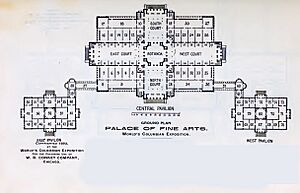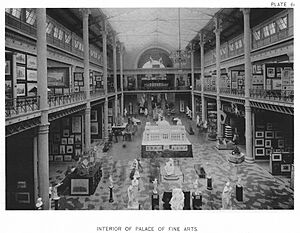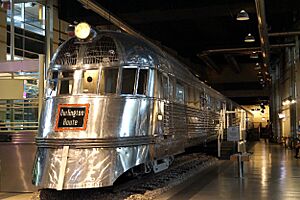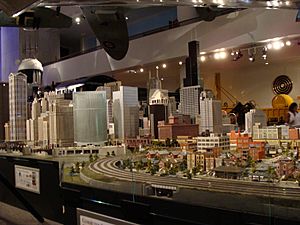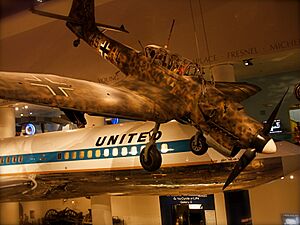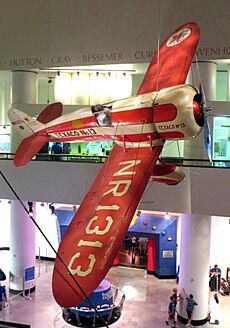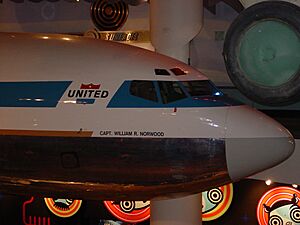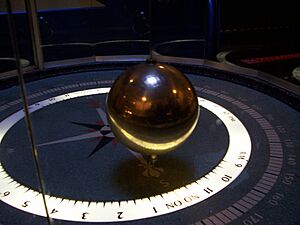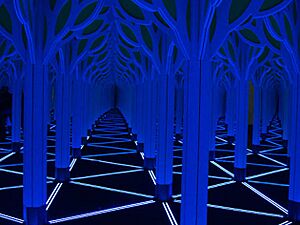Museum of Science and Industry (Chicago) facts for kids
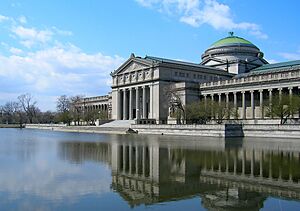
The south facade of the Museum of Science and Industry overlooks a reflecting lagoon in Jackson Park.
|
|
| Former name | Chicago Museum of Science and Industry, Rosenwald Industrial Museum |
|---|---|
| Established | 1933 |
| Location | 5700 South DuSable Lake Shore Drive (at East 57th Street), Chicago, Illinois, US, 60637 |
| Type | Science and technology museum |
| Visitors | 1.5 million (2016) |
| Founder | Julius Rosenwald |
| Public transit access | CTA Bus routes: Routes 6 and 28 (to 56th Street and Hyde Park Boulevard) Route 10 (to Museum of Science and Industry) Route 55 (to Museum of Science and Industry) Metra Train: 55th–56th-57th Street Station (between Stony Island and Lake Park Avenues) |
| Designated: | November 1, 1995 |
The Museum of Science and Industry (MSI) is a fun and educational science museum. It is located in Jackson Park in the Hyde Park neighborhood of Chicago, Illinois. The museum is right next to Lake Michigan and the University of Chicago.
The museum building was originally the Palace of Fine Arts. It was built for the 1893 World's Columbian Exposition, a huge world's fair. The museum first opened in 1933. This was during another big event called the Century of Progress Exposition. A kind businessman named Julius Rosenwald helped start the museum. He gave a lot of money to make it happen. In 2024, the museum was renamed the Kenneth C. Griffin Museum of Science and Industry. This was after a very large donation from Kenneth C. Griffin.
MSI has many amazing exhibits. You can explore a real-size coal mine. There's also a World War II submarine called German submarine U-505. You can see a United Airlines Boeing 727 airplane. Another cool exhibit is the Pioneer Zephyr, which was the first streamlined diesel train in the US. The museum also has the command module from the Apollo 8 spacecraft. This spacecraft was the first to carry humans around the Moon. You can also find a giant model railroad. The museum's exhibits cover many topics. These include manufacturing, environmental science, and how the human body works.
Contents
History of the Museum
Building the Palace of Fine Arts
The building that is now the Museum of Science and Industry was first called the Palace of Fine Arts. It was built for the 1893 World's Columbian Exposition. This was a huge fair that showed off new ideas and art from around the world. The building was designed by Charles B. Atwood. During the fair, it displayed paintings, drawings, and sculptures.
Most buildings at the fair were temporary. They were part of the "White City" and were made of plaster. But the Palace of Fine Arts was different. It had a strong brick base under its plaster outside. This made it more permanent.
After the World's Fair, the building became the Columbian Museum. This museum showed collections left over from the fair. Later, it became the Field Museum of Natural History. In 1920, the Field Museum moved to a new building. This left the Palace of Fine Arts empty.
A professor named Lorado Taft wanted to save the building. He led a public effort to restore it. He hoped it would become an art museum focused on sculpture. People voted to approve money to fix the building. But after a few years, the building was chosen for a new science museum instead.
Creating the Museum of Science and Industry
At this time, a group called the Commercial Club of Chicago wanted to create a science museum. Julius Rosenwald, who was the president of Sears, Roebuck and Company, helped make this happen. He promised to give $3 million to turn the Palace of Fine Arts into a museum. He ended up giving over $5 million.
To change the building, its outside was covered in limestone. This kept its original 1893 Beaux Arts look. But the inside was completely new. It was designed in the Art Moderne style by Alfred P. Shaw.
Rosenwald started the museum organization in 1926. He did not want his name on the building. For the first two years, it was often called the "Rosenwald Industrial Museum." In 1928, its name officially became the Museum of Science and Industry. Rosenwald wanted the museum to be like the Deutsches Museum in Munich, Germany. He had visited that museum in 1911.
The museum looked for its first director. They chose Waldemar Kaempffert, a science editor from The New York Times. He shared Rosenwald's ideas. Kaempffert and his team visited other science museums in Europe. These included the Science Museum in London and the Technical Museum in Vienna. These museums helped them plan MSI's exhibits.
Opening and Changes
The museum was renovated. It opened to the public in stages between 1933 and 1940. The first opening was during the Century of Progress Exposition. Some of the museum's leaders and exhibits came from this event.
In 1992, the museum started planning big renovations. This included building an underground parking garage. This garage was finished in 1998. These changes also added a new main entrance underground. Visitors now go down into this hall before going up into the main building. This is similar to the entrance at the Louvre Pyramid in Paris.
For its first 50 years, it was free to enter MSI. Some special exhibits, like the Coal Mine, cost a small fee. General admission fees started in the early 1990s. The price has increased over the years. However, the museum still offers many "free days" for people living in Illinois.
New Name for the Museum
On October 3, 2019, the museum announced a name change. It would become the Kenneth C. Griffin Museum of Science and Industry. This was after a $125 million donation from billionaire Kenneth C. Griffin. It was the largest gift the museum had ever received. The museum's president, David Mosena, said the official name change would take time. He also said part of the gift would fund a new digital gallery. Chevy Humphrey became the museum's president and CEO in January 2021. The new name and logo were officially revealed on May 19, 2024.
In 2025, the Driehaus Foundation gave $10 million to the museum. This money will help renovate the south entrance. This entrance was the main one during the 1890s world's fair. It faces the nearby Barack Obama Presidential Center.
Museum Exhibits
The museum has over 2,000 exhibits. They are displayed in 75 main halls. Many of the big exhibits are always there. Some special exhibits, like the Coal Mine and the U-505 tour, cost extra. Other exhibits need a free timed ticket. Many exhibits are interactive, meaning you can touch and play with them. This was part of Julius Rosenwald's original idea for the museum.
Entry Hall Exhibits
Pioneer Zephyr Train
The Pioneer Zephyr is a famous train. It was the first diesel-powered, streamlined train made of stainless steel. It is always on display in the Entry Hall. The train used to be outside. It was moved indoors when the museum built its underground parking lot in the 1990s.
NASCAR Next Gen 2023 Ford Mustang
A special NASCAR race car was added to the Entry Hall. It is a Next Gen Ford Mustang. Local Chicago artists painted it. This car shows off modern race-car engineering. It will be at the museum until 2026.
Lower Level Exhibits
U-505 Submarine
German submarine U-505 is a German submarine. It was captured by the Allies during World War II. It is one of only six such submarines captured. Since 1954, it has been the only one on display in the Western Hemisphere. The museum made the U-505 exhibit a permanent war memorial in 1954. The submarine was named a National Historic Landmark in 1989.
For 50 years, the U-505 was displayed outside. In 2004, it was restored and moved inside. The new indoor exhibit opened in 2005. The submarine is in a large concrete bunker. The exhibit also has items found on board. You can play interactive games about how a submarine works. You can take a guided tour inside the submarine for an extra fee.
Outside the exhibit, you can find a Mold-A-Rama machine. It makes a small plastic submarine. There is also a machine that flattens pennies with U-505 designs.
Henry Crown Space Center
The Henry Crown Space Center is in its own part of the museum. It opened in 1986. It was updated and reopened in 2024.
The Space Center has the Apollo 8 command module. This module carried the first humans around the Moon. You can also see the Mercury-Atlas 7 capsule. This capsule carried the second American to orbit Earth. There is a NASA lunar module trainer. It was used to practice for the Apollo lunar landings. A SpaceX Dragon 1 cargo spacecraft is also on display.
Inside the Henry Crown Space Center is the Giant Dome Theater. It shows movies on a huge, curved screen. The screen is five stories tall.
FarmTech Exhibit
The FarmTech exhibit shows modern farming methods. It explains how farmers use new technology like GPS systems. These systems help them work better on the farm. The exhibit includes a tractor and a combine harvester from John Deere. It also has a greenhouse. There is a pretend kitchen showing how much of our food comes from soybeans. You can also learn about how we use cows.
Other Lower Level Exhibits
The museum's lower level has two transportation exhibits. One shows models of "Ships Through the Ages." The other has a collection of old racing cars.
There are also several single-room exhibits. Black Creativity: Architecture explores the history of Black architects. This is part of the museum's Black Creativity program. Mold-A-Rama™: Molded for the Future shows Mold-A-Rama machines. It explains how plastic items are made. Colleen Moore's Fairy Castle is also on display. It is a very detailed miniature fantasy house. It has been at the museum since 1949. 90 and Beyond opened in 2023. It celebrates MSI's 90th anniversary. It shows objects from each of the museum's nine decades.
Some lower-level exhibits are for younger children. The Swiss Jollyball is a huge kinetic art piece. It was built from salvaged junk. A metal ball moves on a track. The museum calls it the largest "pinball machine" in the world. The Idea Factory is a water play area for toddlers. The Eye Spy gallery is a hallway with funny scenes behind windows.
First Level Exhibits
Transportation Gallery
The Transportation Gallery is in the east part of the museum. It covers the first and second levels. It has several permanent exhibits.
In the middle of this area is The Great Train Story. This is a huge model railroad. It covers 3,500 square feet. It shows a detailed version of the "Empire Builder" train line. This line goes from Chicago to Seattle. You can see tiny versions of downtown Chicago, the Great Plains, and the Rocky Mountains.
On the main level, you can see NYC & HRR Locomotive No. 999. This train was called the Empire State Express. Some say it was the first steam train to go over 100 miles per hour. It was given to the museum in 1962. It was displayed outside until 1993, when it was moved indoors and restored.
The first level also has a copy of Stephenson's Rocket. This was the first steam train to go over 25 miles per hour. There are also old and new road vehicles.
The second level of the Transportation Gallery has the Take Flight exhibit. It features the first Boeing 727 jet plane used by airlines. United Airlines donated it. One wing was removed, and holes were cut in the side. This lets visitors go inside. A working copy of the Wright Brothers' first airplane, the Wright Flyer, is also on display.
Two World War II warplanes are also shown. Both were given by the British government. One is a German Ju 87 R-2/Trop. Stuka dive-bomber. It is one of only two complete Stukas left. The other is a British Mark 1A Supermarine Spitfire.
Science Storms
Science Storms opened in March 2010. It is a permanent exhibit that covers multiple levels. On the first level, you can see a 40-foot water vapor tornado. There's also a spinning sand avalanche. A Foucault pendulum hangs from the ceiling. You can also find a tsunami wave tank and hot air balloons. A system with solar panels powers cars. There's a section about light and color. On the second level, a Tesla coil fires electricity every 30 minutes. You can also see a Wimshurst machine from the 1800s. There's a giant Newton's cradle and sections on fire, chemistry, and magnetism.
Coal Mine
The Coal Mine exhibit is in the south part of the museum. It shows what a real deep bituminous coal mine was like. It uses original equipment from a mine that closed in 1923. This is the museum's oldest exhibit, opening in 1933. Guides dressed as "coal miners" lead visitors through. You get to ride a real mine train. You learn about the history of mining and how coal is produced. The experience takes about 30 minutes and costs extra.
Griffin Studio & Notes to Neurons
The Kenneth C. Griffin Studio opened in 2024. It is an "immersive multimedia experience." It uses projections, sound, and movement tracking. Its first show is called Notes to Neurons. It explores how music affects the human mind and body.
Numbers in Nature: A Mirror Maze
Numbers in Nature: A Mirror Maze teaches about patterns in nature. You can learn about the Golden Ratio, spirals, and fractals. It also has a mirror maze. This maze shows geometric patterns. You need a free timed ticket for this exhibit.
The Blue Paradox
The Blue Paradox is an immersive exhibit. It talks about the problem of plastic in our oceans. It opened on July 1, 2023. It was first shown in London.
Genetics: Decoding Life
Genetics: Decoding Life shows how genetics affect humans and animals. It has a chick hatchery. You can watch baby chickens hatch from their eggs. There is also a pen for chicks that have already hatched. The exhibit also has genetically modified frogs, mice, and plants that can survive dry weather.
The chick hatchery has been at the museum since 1956. About 20 chicks hatch each day. Around 8,000 chicks hatch in a year. Some of the chicks are a rare type called Java species. These are sent to a farm in La Fox, Illinois, to help save the breed.
Yesterday's Main Street
Yesterday's Main Street looks like a Chicago street from the early 1900s. It has cobblestone roads and old-fashioned lights. There are also fire hydrants. Several shops are set up, including early versions of Chicago businesses. These include:
- The Berghoff restaurant
- Chicago Post Office
- Commonwealth Edison
- Gossard Corset Shop
- Jewel Tea Company grocery
- Jenner and Block Law office
- Lytton's Clothing Store
- Dr. John B. Murphy's office
- The Nickelodeon Cinema
- Chas. A. Stevens & Co.
- Walgreens Drug Company
You can go inside the Nickelodeon Cinema. It plays silent films all day.
ToyMaker 3000
ToyMaker 3000 is a working assembly line. Visitors can order a "Gravitron" spinning top toy. Then, they watch it being put together. This exhibit is sometimes closed for repairs.
Wanger Family Fab Lab
The Wanger Family Fab Lab is a digital workshop. It has 3D-printers and laser-cutters. It has other tools to create "almost anything you can imagine." You can see it through windows. It is used for museum workshops and summer camps.
Other First Level Exhibits
Extreme Ice shows how climate change affects Earth's polar ice caps. It has equipment used to study climate. There are interactive screens and a large ice wall you can touch.
The Art of the Bicycle opened in 2013. It shows the history of bicycles. It also explains how modern bikes keep changing.
Earth Revealed has a "Science on a Sphere" globe. This globe projects holographic images. It has presentations about planets and space. It also shows movies about rising sea levels and water use.
The Whispering Gallery opened in 1938. It is a room shaped to reflect sound in a special way.
Second Level Exhibits
YOU! The Experience
YOU! The Experience is about life science and how the human body works. It has a 13-foot-tall, interactive, 3D heart. There are screens that track your movement. You can try a human-sized hamster wheel. The exhibit also shows plastinated human remains to teach about anatomy.
Other Second Level Exhibits
The Regenstein Hall of Chemistry has a giant periodic table of the elements. It shows samples of each element. There are also displays about food and materials science.
Above the Coal Mine exhibit, you can see the Travel Air Type R Mystery Ship. It was called "Texaco 13." This airplane set many world records for flying.
At the back of the Take Flight exhibit, there are flight simulators. Visitors can pretend to fly old fighter planes. Motion simulators let you experience a journey through the sky or space.
Past Exhibits
Some exhibits that were once at MSI are no longer there. An F-104 Starfighter airplane was at the museum from 1978 to 1993. It was then sent to another museum. A Santa Fe Steam Locomotive was moved from outside the museum in 1995.
Telefun Town was an exhibit about telephone communication. It is no longer there. A well-known past exhibit was a walk-through model of the human heart. It was removed in 2009.
Fast Forward... Inventing the Future showed new technologies. It closed in 2022. Out of the Vault showed objects from the museum's collections. It also closed in 2022. The Spaceport exhibit was about space exploration. It had costumes from Star Trek. It closed in 2022. Future Energy Chicago was about alternative energy. It closed in August 2022.
Special Exhibitions
Besides its regular exhibits, the museum also hosts temporary shows. These exhibitions usually last less than a year. They often require a separate ticket.
Some past special exhibitions at MSI include:
- Titanic: The Exhibition, which showed many items from the wreck of RMS Titanic.
- Gunther von Hagens' Body Worlds, which showed the human body using plastinated specimens.
- Game On, about the history and culture of video games.
- Leonardo da Vinci: Man, Inventor, Genius
- CSI: The Experience
- Robots Like Us
- City of the Future
- Star Wars: Where Science Meets Imagination
- The Glass Experience
- Harry Potter: The Exhibition
- Robot Revolution, which was sponsored by Google. It had many hands-on activities.
- Four versions of Smart Home: Green + Wired, showing green architecture.
- The Science Behind Pixar (opened May 24, 2018).
- Wired to Wear, about wearable technology (opened March 21, 2019).
- Marvel: Universe of Super Heroes (opened March 7, 2021).
- The Art of the Brick (opened February 10, 2022).
- Pompeii: The Exhibition (opened February 23, 2023).
- 007 Science (opened March 7, 2024).
Every year, from late November to early January, the museum hosts two special holiday shows. These are Christmas Around the World and Holidays of Light. They feature Christmas trees decorated in the style of different cultures. They also have displays about other holiday celebrations. This tradition started in 1942 with just one tree. Now, there are more than 50 trees.
See also
 In Spanish: Museo de Ciencia e Industria (Chicago) para niños
In Spanish: Museo de Ciencia e Industria (Chicago) para niños
- Architecture of Chicago
- List of museums and cultural institutions in Chicago


